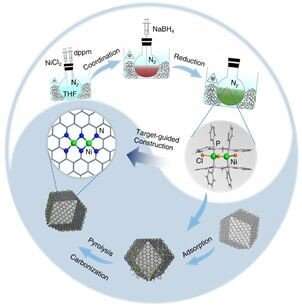Researchers design dinuclear-site catalysts and reveal the underlying mechanism

Dinuclear-site catalysts (DSCs) have drawn more and more attention from researchers due to their excellent catalytic ability through incorporating two adjacent metal atoms as the catalytic center, which helps the usage of the potential synergistic interaction.
However, it's challenging to precisely synthesis diatomic sites, so as to obtain catalysts with accurate dinuclear structure. Prof. Yao Tao with his group, from the University of Science and Technology of China (USTC) of the Chinese Academy of Sciences (CAS), proposed a method to synthesis uniform atomically precise Ni2 sites, collaborating with Prof. Zhu Manzhou from Anhui University and Prof. Li Yafei from Nanjing Normal University. The calculated results also identified the structural evolution of dinuclear active site during electrocatalytic CO2 reduction conditions for the first time. This work was published on the Journal of the American Chemistry Society.
To obtain the dynamic structures of catalytically active diatomic sites, scientists chose Ni2(dppm)2Cl3 (dppm referring to bis(diphenylphosphino)methane, Ph2PCH2PPh2), a ligand-protected diatomic cluster, as the metal precursor to introduce the metal atoms. Then the precursor was heated together with nitrogen-doped carbon to obtain supported dinuclear Ni2 site (Ni2/NC). This novel catalyst exhibited superior catalyzing performance as well as stability.
In order to figure out the real mechanism, researchers applied operando X-ray absorption fine structure (XAFS) technique to measure the charge transition of specific atoms and to make conclusions on atomic level. They unambiguously confirmed the atomic and electronic structural changes of dinuclear sites and discovered the dynamic bridge-oxygen adsorption to form active intermediate O-Ni2-N6.
Moreover, researchers also conducted the density function theory (DFT) calculations to provide theoretical explanations. Results suggested that the observed O-Ni2-N6 structure acted as the dominating reaction intermediate to form CO, leading to satisfactory selectivity and yield.
This work is instructive to design new dinuclear-site catalysts, and provide novel insights for understanding catalyzing effect. These results are also promising for solving energy problem in the future.
More information: Tao Ding et al, Atomically Precise Dinuclear Site Active toward Electrocatalytic CO2 Reduction, Journal of the American Chemical Society (2021). DOI: 10.1021/jacs.1c05754
Journal information: Journal of the American Chemical Society
Provided by University of Science and Technology of China



















